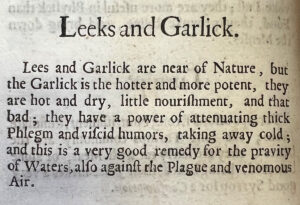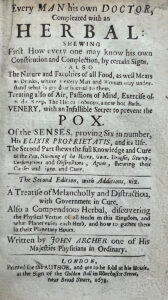By Zoe Sperry
Did you know that eating onions can cause turbulent dreams? Or that artichokes can trigger spells of vertigo? Rest assured these are not claims substantiated by modern medicine, but rather by the seventeenth-century physician named John Archer in his book, Every Man His Own Doctor (1673). This book is an insightful glimpse into early modern ideas about diet and the lifestyle factors that impact our health. Archer’s book is small in size, but it is packed full with practical information. Simplicity and conveniency are its aims, for Archer made his book “especially for those that have not patience to Read Voluminous Authors”. The book is easy to navigate; sections and chapters tackle different elements of health – from the quality of the air, to diet, sleep and exercise. Then within these chapters are various sub-headings that separate the content, making it easy to find specific information.
While the basics of nutrition are commonplace in today’s biology classes, it was not as widespread in the early modern period. Archer’s book is an attempt to tackle this omission in medical knowledge: “every Man in prudence should so far be his own Doctor, as rightly to know his own Constitution and Complection”. For Archer, it is a human right to understand and manage one’s body and health. It does not require advanced scientific knowledge: “not that I think it necessary that every particular Person should be able to Read an Anatomy Lecture”. What it does require, however, is a degree of sensitivity to one’s body: “Daily experience upon a Mans own Body by help of Sensation, may soon make (if observant to these Small Rules) the Wisest Doctor Living”. Such a claim allows Archer’s dietary advice to be applicable to everyone’s personal experiences of their bodies; his book is instructive rather than prescriptive.

The Cathedral Library has the second edition, published within two years of the first edition of 1671 – there was evidently a demand for Archer’s writings. The book’s popularity is supported by a poem of praise from Archer’s friend “E.P.”: “thy famed skill and Reason… Makes thy loud praise through England wide to go.” Placed at the start of the book, the poem entices readers and convinces them to read on.

Archer’s book is poised between old Galenic thought and the emerging mechanical perspective on the body. Galen, an influential classical writer, theorised the body was composed of four primary fluids (also known as humors) – blood, phlegm, yellow bile (choler) and black bile (melancholy) – which impacted mood and were all expected to be in balance in the ideal healthy body. Diet and lifestyle habits could disrupt this balance – for example, as Archer contends, leeks and garlic have “a power of attenuating thick phlegm and viscid humors”. However, in the mid-seventeenth century, there was a movement away from Galenic theory to a mechanistic approach to health, whereby the body was understood in terms of nerves, vessels, tubes, and fibres, and the circulation of the blood. Despite his Galenic vocabulary, Archer does implement some of these new ideas; for example, he notes how beef does “not easily pass through the Veins”, and how strenuous exercise “dissolves the strength of the Nerves and Ligaments, and sometimes breaks the lesser Veins”. However, this new vocabulary is sparse in comparison to the Galenic one; Archer, who had earlier contended that knowledge from an “Anatomy Lecture” is unnecessary, adheres to his desire not to alienate readers, and he does so by using Galen’s theoretical model which would have been more widely recognizable. An early modern reader would therefore have been better able to navigate Archer’s advice; for example, if melancholy was a dominant humor in your body, perhaps give apples a try, for they can “exhilarate the mind” and are “very beneficial to those which are troubled with Melancholly”.
 Beyond diet and lifestyle advice, Archer also included a section on the prominent diseases of the time. The title page indicates a particular concern with Pox, displaying it in large capital letters to catch the eye; but Archer also covers other illnesses like gout, dropsy, scurvy, and consumption. In the preface “To the Reader,” he dedicates his book “for such as are distempered,” and he aims to have the symptoms of these diseases “clearly laid down” and their “best Cure faithfully propounded”. Considering the Great Plague struck London eight years prior to the publication of Archer’s text, it is no surprise Archer can sense a “distempered” audience, and he hopes to appease some of these anxieties by providing clear and faithful advice. Rather than keeping this medicinal knowledge amongst physicians, Archer’s book sought to spread it as a preventative measure against sickness.
Beyond diet and lifestyle advice, Archer also included a section on the prominent diseases of the time. The title page indicates a particular concern with Pox, displaying it in large capital letters to catch the eye; but Archer also covers other illnesses like gout, dropsy, scurvy, and consumption. In the preface “To the Reader,” he dedicates his book “for such as are distempered,” and he aims to have the symptoms of these diseases “clearly laid down” and their “best Cure faithfully propounded”. Considering the Great Plague struck London eight years prior to the publication of Archer’s text, it is no surprise Archer can sense a “distempered” audience, and he hopes to appease some of these anxieties by providing clear and faithful advice. Rather than keeping this medicinal knowledge amongst physicians, Archer’s book sought to spread it as a preventative measure against sickness.
Archer claims in his preface that “many dig their Graves with their Teeth”, which is certainly harsh, but it is an attitude of tough love that Archer infuses throughout his writing. At the heart of Archer’s text is the notion that individuals have agency over their health, an idea propounded by most dietary advice today. Despite its outdated medical knowledge, Every Man His Own Doctor is perhaps not so dissimilar to some of our modern beliefs, such as “an apple a day keeps the doctor away.”